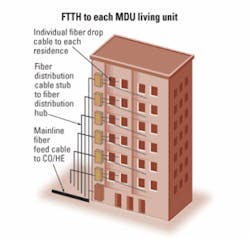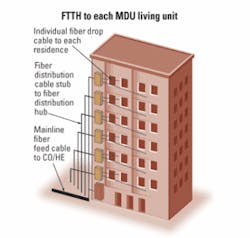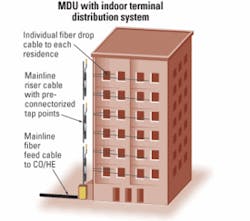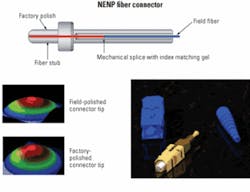Fiber’s right at home in multidwelling units
by Mark Turner
Approximately 25% of residences in the U.S. fall within multidwelling unit (MDU) buildings. MDUs can be either tower-style or clustered together within complexes, like condominiums and apartments. Just like single-family homes, many of which already have a fiber-to-the-home (FTTH) connection, each living unit within MDU buildings needs its own high-speed optical connection for maximum communications throughput, true broadband reliability, and minimum Internet wait time. What MDUs now offer carriers in addition is a better chance to generate more revenue as well as lowering the installation cost of a given FTTH investment.
Figure 1 depicts a 120‑unit tower having a fiber cable fed into the building (e.g., a 144-fiber strand, gel-free ribbon cable), a fiber distribution hub, prestubbed fiber distribution terminals having 12 fibers per floor, and finally, a singlemode-fiber drop cable run to each living unit on the floor.Realizing that each building may not necessarily have enough clearance in the riser shaft to pass the distribution cables down to the hub prompted the development of an indoor, flame-retardant fiber distribution system called the terminal distribution system. Now, instead of filling the riser with multiple distribution cable stubs, a single 144-fiber cable suffices. In this example, at each closet location, the cable would have already been mid-span accessed at the factory, and those 12 fibers now would appear inside a convenient, multifiber MT connector jack. Figure 2 illustrates the indoor terminal distribution system.
A space-saving 12-fiber assembly can now quickly and easily connect the matching multifiber MT plug at each closet tap point to its riser jack. The other end of the MT plug cable would be preconnectorized with single-fiber connectors like the popular SC APC type that land inside a fiber distribution terminal at the telecom closet (see Fig. 3).The factory-assembled and preconnectorized terminal distribution system for the MDU tower benefits the network owner by significantly lowering installation time and construction cost and conserving precious riser space.
Now, onto that critical segment, the fiber drop cable to each living unit down the MDU hallway, which ensures scalable and reliable fiber bandwidth to and from each living unit for many years to come. The fiber drop is now being terminated after installation with a time-proven method-the no-epoxy and no-polish (NENP) connector. These two critical optical fiber interconnection steps, securely bonding the fiber to the connector ferrule and then precisely polishing the ferrule tip, have already been taken care of at the factory.What is new with the NENP connector technology is the capability for a “go” or “no-go” indication during fiber termination as well as highest return loss via angled physical contact (SC APC) of the fibers. An innovative laser cleave at the factory, the angled field fiber cleaver, and enhanced installation tool with built-in fiber-to-fiber contact indicator all work in concert to maximize fiber termination yield in less than two minutes per connector.
The NENP connector’s unique design sets it apart from lesser-quality, time-intensive field-polished connectors with less durability and significantly higher-cost “pigtail-spliced” fiber terminations. Additionally, it ratchets the proven NENP field-installable connector performance up another notch. Figure 4 shows the NENP field-installable fiber connector.
FTTH was initially deployed to single-family homes, but now MDUs are being rightfully targeted for highest residential density, achieving top-line broadband services growth. There is also another economic incentive to deploy FTTH to living units inside MDUs, lowering the cost to install mainline fiber distribution and fiber drop cables to an equal number of homes.
The indoor terminal distribution system and NENP fiber termination technologies easily ensure the highest quality and most durable optical performance while taking the least time in the field to install.Mark Turner is manager, consultant engineers, at Corning Cable Systems (www.corningcable.com).




